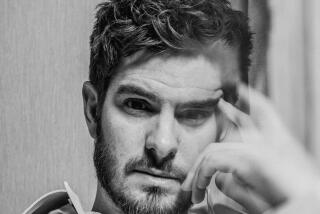A star’s brief shining
- Share via
Tears were welling up in Julie Garfield’s eyes and her voice was wavering as she introduced the moving new Turner Classic Movies documentary about her legendary father, John Garfield, at a screening last week at Warner Bros.’ studio. It was fitting that “The John Garfield Story” had its West Coast premiere at the Burbank studio because Garfield was one of Warner’s biggest stars during the late 1930s and the ‘40s.
Garfield was also one of cinema’s most influential actors. He was the first rebel without a cause -- the precursor of the likes of Montgomery Clift, James Dean, Paul Newman, Marlon Brando, Al Pacino, Robert De Niro and Sean Penn.
Yet his movie career lasted only 13 years. He died at age 39 in 1952, succumbing to a massive heart attack in the New York apartment of a female friend. But according to his daughter, family and friends, it was the House Un-American Activities Committee that killed him.
Garfield was the most popular, highest-profile actor to be blacklisted during the insidious Communist witch hunts of the Cold War. Garfield, a well-known liberal and progressive, insisted he wasn’t a Communist but refused to name names. His wife, Roberta, from whom he was separated at the time of his death, had been a Communist Party member.
Narrating the documentary and working with its filmmakers, Joan Kramer and David Heeley, has been a cathartic experience for Julie Garfield, an actress who appeared in such films as “GoodFellas” and is carrying on her father’s legacy as an acting teacher in New York City. “What happened to him was so horrible,” says his daughter, 57, who was just 6 when he died. “My mother was so angry at Hollywood. She conveyed a very mixed message to me to what being an actor was. If you were an actor you could easily get destroyed. My mother never pursued anything, even getting him a star on Hollywood Boulevard. I was sort of trapped into this child’s sadness and feeling of being a victim.”
Clips and interviews
“The John Garfield Story,” which premieres tonight on TCM, is a wonderful introduction to the actor who came to fame in 1938 in the weepy “Four Daughters” and went on to make such classics as “Pride of the Marines,”’ “The Postman Always Rings Twice,” “Body and Soul,” “Force of Evil” and “The Breaking Point.” The documentary is filled with clips from his movies and interviews with friends and fans such as Richard Dreyfuss, Joanne Woodward, Hume Cronyn, Norman Lloyd and Danny Glover. The hourlong program kicks off a 25-film festival of Garfield’s work on TCM.
Movie audiences had never seen anyone like Garfield when he burst onto the scene in “Four Daughters,” for which he received his first Oscar nomination.
Garfield’s Mickey Borden was a striking combination of toughness and tenderness, a Depression-era kid bitter about the breaks he had been dealt but who still managed to exude charm and magnetic sex appeal. He was heartbreaking in the scene when he tells costar Priscilla Lane that the “fates and destinies” would never let him win.
“He was the prototypical Depression rebellion youth,” says Lloyd (“St. Elsewhere”), who first met Garfield in New York in 1937 and appeared with him in “He Ran All the Way” in 1951.
“He combined all of those elements of darkness and rebelliousness with the charm and the poignancy, and he became the prototypical actor of that time. He never changed as a person. He remained just as a wonderful guy. He was a man of great charm, a good fellow, very likable.”
Born Jacob Julius Garfinkle in 1913 on the Lower East Side of New York to poor Russian Jewish immigrants, Jules, as he was known, grew up tough on the dead-end streets. His mother died when he was 7. “He hated his father,” Julie Garfield says. “His father was awful to him. He was torn away from his brother.”
Salvation came from noted New York educator Angelo Patri, whose PS 45 high school was for problem children. He became a surrogate father to young Jules. Under his tutelage, Garfield boxed, joined the debate team and discovered he had a gift for acting.
He received a scholarship as a teenager to noted actress Maria Ouspenskaya’s drama school, joined the Civic Repertory Theater in 1932 and changed his name to Jules Garfield. He shortly thereafter made his Broadway debut in “Counsellor-at-Law” and became the youngest member of the prestigious Group Theatre, appearing in the company’s landmark productions of Clifford Odets’ “Waiting for Lefty” and “Awake and Sing.”
He signed a contract with Warner Bros. in 1938, when he was passed over for the lead in the Group Theatre production of Clifford Odets’ “Golden Boy.” Although Odets told Garfield he had written the play, about a young man torn between the boxing ring and his love for the violin, for Garfield, director Harold Clurman cast Luther Adler in the lead and gave Garfield a supporting role.
Despite his disappointment, Garfield never turned his back on the Group Theatre or Broadway in general. His contract stated that he could return to the stage every year and he did many plays in between film roles.
Warner Bros., though, tried to turn Garfield into one of its tough guys like Cagney, and cast him in a series of forgettable movies. Despite the “B” material, Garfield always managed to give “A” performances.
He struck pay dirt when Warners lent him to MGM for the 1946 adaptation of James M. Cain’s novel of love, lust and murder, “The Postman Always Rings Twice.” In a performance filled with subtlety and sexual fire, Garfield plays a young drifter who falls in love with the gorgeous young wife (Lana Turner) of an older man. They have a heated affair and decide to kill the husband.
First film success
After making the popular 1946 romantic drama “Humoresque,” with Joan Crawford, for Warner Bros., he and business partner Bob Roberts set up their own independent production company, Enterprise Studios. They scored a phenomenal critical and commercial hit with their first film, 1947’s “Body and Soul.” Garfield received a best actor Academy Award nomination for his role as a slum kid who becomes a prizefighter. Garfield was equally impressive in Enterprise’s second production, the 1948 film noir “Force of Evil,” in which he played a Wall Street attorney working for a numbers gang.
He also offered fine performances in “We Were Strangers” in 1949 and “Under My Skin” in 1950 and demonstrated a new maturity with “The Breaking Point” (1950), based on Hemingway’s “To Have and Have Not.” But when he refused to cooperate at his HUAC hearing in 1951, his film career came to a standstill. Just a few months before his death, he finally got to play the lead in a short-lived Broadway revival of “Golden Boy.”
Julie Garfield remembers her father being “just plain devastated” by the blacklist. But she tries to maintain the happier memories. “When he smiled on you it was like being in the sun,” she says, her voice welling with emotion. “He was funny and sometimes he would like to dance and kick up his legs. I remember him adoring me. He used to take me to the merry-go-round a lot in New York.
“He was so strong, so handsome and he loved to kid me. He would give me this mischievous smile. I wish I remembered more about him....”
*
‘The John Garfield Story’
When: 5 and 8 p.m. tonight
Where: Turner Classic Movies
What Else: Also airing tonight on TCM: “The Postman Always Rings Twice” at 6 p.m.; “Force of Evil” at 9 p.m.; “He Ran All the Way” at 10:30 p.m.; “Nobody Lives Forever” at midnight; and “Out of the Fog,” Tuesday at 2 a.m.
More to Read
Only good movies
Get the Indie Focus newsletter, Mark Olsen's weekly guide to the world of cinema.
You may occasionally receive promotional content from the Los Angeles Times.








